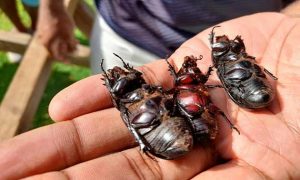Armed with a New Training Manual, Pacific Farmers Look to Control Deadly Coconut Rhinoceros Beetle Infestations
 3 September 2021
3 September 2021

By External Source
SUVA, Fiji, Sep 3 2021 (IPS-Partners)
The Pacific has been battling the spread of the Coconut Rhinoceros Beetles (CRB) for years and is now challenged by the invasion of a new CRB biotype, the CRB-Guam strain, that has spread to seven Pacific Island countries in just a decade leaving thousands of dead palms in its wake. The Guam strain, together with much more established biotype CRB-S has hampered the success of renovation programmes for mature tall palms as well as newly emergent, high-value coconut product industries (such as virgin oil and coconut water) that offer economic opportunities for communities in the region.
To control the spread of this new strain in the Pacific, The Coconut rhinoceros beetle (Oryctes rhinoceros): A manual for control and management of the pest in Pacific Island countries and territories was compiled and included knowledge from the experience of staff from the Pacific Community (SPC) who have worked to control and manage the pest over the years.
Approximately 600 training manuals on Coconut rhinoceros beetle (CRB) control and management have been published and distributed to Vanuatu, Solomon Islands and Papua New Guinea under the Pacific Awareness and Response to Coconut Rhinoceros Beetle (PARC) project implemented by the SPC’s Land Resources Division (LRD).
“The manual draws from extensive literature on CRB, particularly in relation to the Pacific Island countries and Territories (PICTs),” said LRD Director, Karen Mapusua.
“The Pacific Community is guiding the CRB management efforts through the PARC project, working closely with Vanuatu, PNG and Solomon Islands biosecurity. We hope this manual which is aimed at the new generation of scientists, technicians and extension officers will help control such invasive species and promote local agricultural initiatives.”
Mark Ero, Project Manager for PARC said the manual comprehensively captures all the required information about the pest ranging from its bio-ecology, possible high risk spread pathways, surveillance and monitoring procedures. These include delimiting survey procedures, emergency response plan, management options, guidelines for field collection, and tissue preparation for DNA analysis for biotype confirmation.
The manual is divided into three sections. The first section provides a brief review of CRB in the Pacific and an update on its current status. The second provides information on CRB recognition and assessment of the damage it causes, as well as methods for its collection and handling after it has been identified. Relevant contacts are also provided to facilitate access to expert assistance. Methods for further diagnostics are also outlined. Section three covers control actions for CRB region-wide and draws on the experiences of colleagues in the CRB Action Task Force – particularly those working in Guam, Solomon Islands and Papua New Guinea – on how to control the invasive CRB-G biotype.
SPC’s Pest and Disease Management Advisor Fereti Atumurirava says the emergence of CRB-G as an invasive pest underpins the need for a revision of data and a revitalisation of the CRB Integrated Pest Management (IPM) system to protect coconut and oil palm production.
“All governments and stakeholders in the region now have the tools through this manual to react and proactively liaise with SPC-LRD to provide the necessary guidance in preventing arrival, avoiding further spread within existing sites and containing this pest,” said Atumurirava.
The Pacific Awareness and Response to CRB (PARC) is funded by the New Zealand Ministry of Foreign Affairs and Trade (MFAT) and implemented by SPC. It aims to support control efforts of the CRB infestation in the Solomon Islands, Papua New Guinea and Vanuatu, including the new CRB Guam strain.
Source: The Pacific Community (SPC)
